Sharing the Gospel on Twitter
If you’re interested in sharing the gospel through social media, then you should get on board the exciting, fast moving microblogging service Twitter. This is part of LDS.net’s Sharing the Gospel through Social Media series. Check out the introduction, for the series overview. This article will cover the following topics:
- Decide if Twitter’s For You
- Learn About Twitter
- Getting Started
- Signing Up for a Twitter Account
- Finding People to Follow
- Creating a Tweet
- Sharing Content on Twitter
- Terminology
- Measurements of Success
- Conversation Rate
- Applause Rate
- Amplification Rate
- Results
- Getting Started
- Connect with LDS Tweeters
- Who Should I Connect With
- Increasing Your Connections
- Follow other People
- Complete Your Profile
- Focus on Now
- Provide Value
- Advertise Your Username
- Contribute the Gospel on Twitter
- Be Authentic
- Be Consistent
- Edify
- Uplift
- Be Wise
- Be Vigilant
- Don’t Steal
- Caution for Twitter’s Dangers
- Time Wasting
- Anonymity
- Psychological
- Privacy
Article Summary
Twitter is a major player in the social media world. It has the 5th largest user base of any social media site in the world, has a highly engaged user base, and continues to gain in popularity. If you are interested in starting or expanding your social media presence, Twitter is worth considering.
Who is on Twitter?
Twitter reports having more than 250 million active users. While this number may seem much smaller than sites like Facebook, or even Google +, Twitter only reports the number of active users rather than the total number of accounts. Some have estimated the total number of accounts at closer to 1 Billion. And those who are active on Twitter are very active. 46% of Twitter users visit at least every day and 29% visit multiple times per day. Twitter has about 500 million tweets (user generated content) per day. And from June to September of 2014, Twitter averaged 60 billion site views per month. A lot of people are on Twitter.
Who is the Average Twitter User?
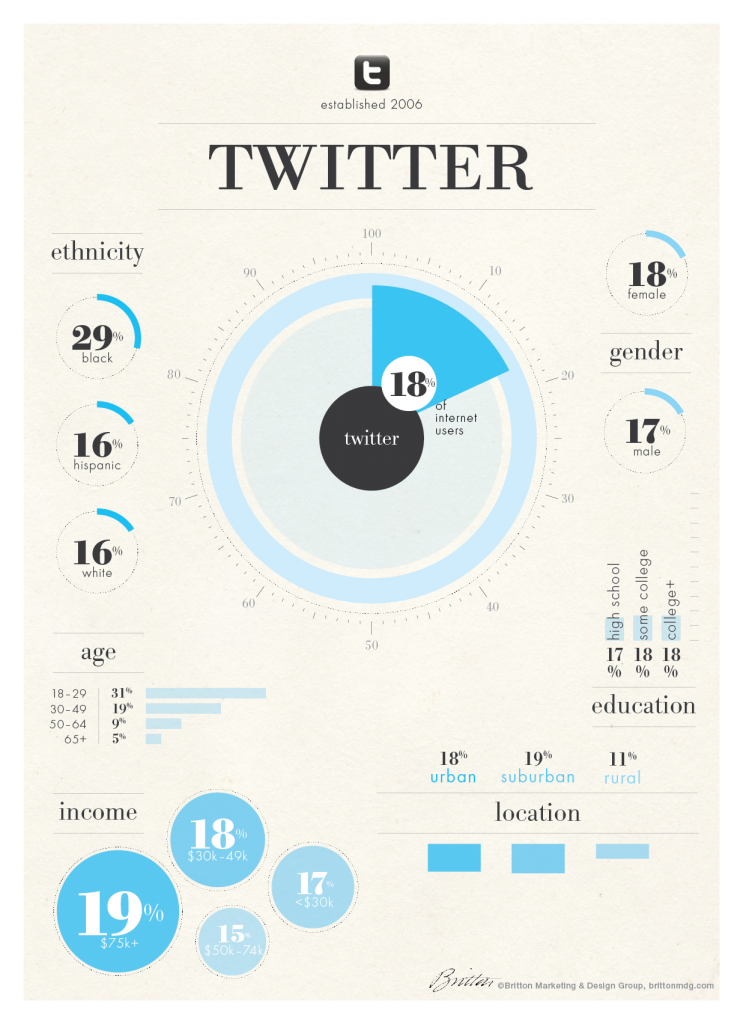
Twitter users skew young. According to a survey early in 2014, more teens called Twitter the most important social network than any other site. And Twitter users tend to be social media savvy, only 2% of them use Twitter as their only social media site. But the most recent trends are pushing the average Twitter user older. Though only 9% of internet users between 50 and 64 years of age currently use Twitter, that number has grown 79% since 2012. While more recent surveys are showing SnapChat surpassing Twitter in popularity among teens. So we may be at the point where Twitter is beginning to enter more securely into the mainstream. As for other demographic breakdowns, different surveys disagree about racial and gender breakdowns. So it’s probably safe to assume there is not a strong lean one way or the others.
What Features Does Twitter Offer?
https://www.youtube.com/watch?v=hB9a4-usOOI Participating in Twitter requires sending tweets, messages limited to 140 characters in length. Tweets can also include links, videos, and images. You can send messages to everyone, directed to an individual, as part of a larger conversation, or in private.
Mentions
One of the most commonly used feature on Twitter is mentions. By simply using the @ symbol and another user’s Twitter username, your message will appear in their notifications. This allows you to communicate directly with friends, family, or public figures. All Twitter messages are public by default. Do not post anything sensitive unless you are certain it is a “Direct Message.”
Hashtags
 Conversations on Twitter are organized through hashtags. Use a the # symbol followed by the conversation you are looking for. You can also search for this hashtag in Twitter’s search feature to find all people talking about this subject. >Hashtags are a great way to bring together people from all over the world with a common interest.
Conversations on Twitter are organized through hashtags. Use a the # symbol followed by the conversation you are looking for. You can also search for this hashtag in Twitter’s search feature to find all people talking about this subject. >Hashtags are a great way to bring together people from all over the world with a common interest.
Trends
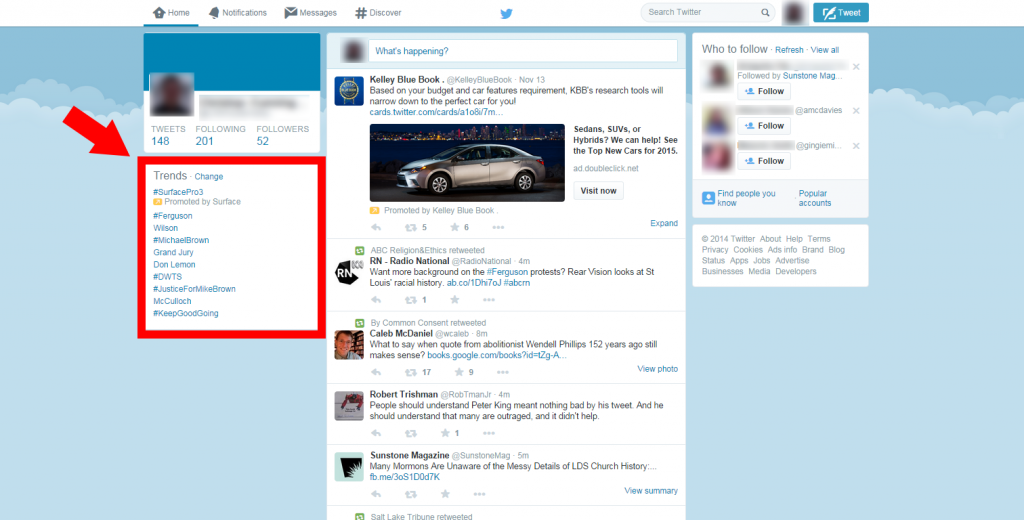 On the left side of the Twitter home page is a list of the phrases and hashtags being used most often on Twitter currently. These are updated in real time, so Twitter can be a source to know what is currently newsworthy and interesting.
On the left side of the Twitter home page is a list of the phrases and hashtags being used most often on Twitter currently. These are updated in real time, so Twitter can be a source to know what is currently newsworthy and interesting.
Profiles
Each Twitter user has a profile page that lists all of their tweets. In addition, users can put two images and a bio on their profile page. Profile pages are not looked at as often on Twitter as on social media sites dedicated to networking.
Mobile Apps
Twitter’s 140 character limit makes it an ideal fit for smart phone users. Twitter has apps available for iPhone, Android, Windows Phone, Nokia, Blackberry, iPad, Android Tablet, and Windows Tablet. 60% of Twitter users access their accounts from a mobile devise at least once a month Because Twitter’s basic interface is so simple, mobile users get the same experience as those visiting the site directly.
What Makes Twitter Unique?
Twitter is most well known for the 140 character limit on tweets. While this is a limitation for writers, it’s a big appeal to those who want to quickly get updates from many different sources. Twitter has also distinguished itself for the one-sided nature of relationships. On Twitter you can interact with public figures without ever receiving a response back. You can follow someone else, without necessarily being followed by them.
What Do People Talk About on Twitter?
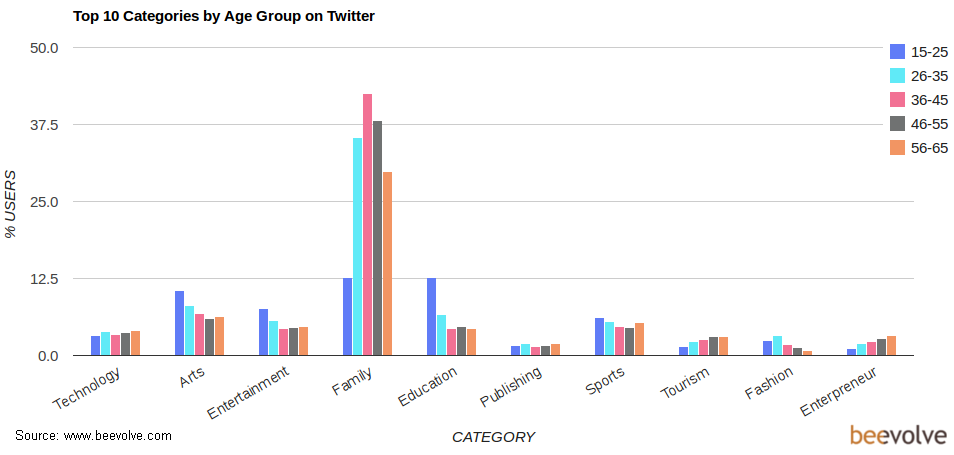 Twitter is a very diverse place. Because of hashtags, people can find the specific topics that interest them. But because of its instant nature, Twitter has become a place to talk about in the moment events, such as news or entertainment. Analysis of the content on Twitter, finds that topics tend to be traditional. Religious content gets retweeted by other users much more often than other kinds of content, and the most popular content is a subject very comfortable for Latter-day Saints. And Family is far and away the most commonly discussed topic on Twitter, among every age group.
Twitter is a very diverse place. Because of hashtags, people can find the specific topics that interest them. But because of its instant nature, Twitter has become a place to talk about in the moment events, such as news or entertainment. Analysis of the content on Twitter, finds that topics tend to be traditional. Religious content gets retweeted by other users much more often than other kinds of content, and the most popular content is a subject very comfortable for Latter-day Saints. And Family is far and away the most commonly discussed topic on Twitter, among every age group.
Should You Use Twitter?
Twitter is perfect for people on the go, and those wanting to connect with younger users. Twitter is good for people who want the flexibility between a broad network along with the tools to find the niche conversations you are looking for. And Twitter is perfect for those who want to talk about family and faith. Because of it’s unique features, Twitter is often an ideal second social network to complement your other social media sites. Twitter is not ideal for those who want to create online communities, or want any privacy. It’s also a bad fit for those who want to share lots of pictures, or longer written content. 
Getting Started
Signing Up for a Twitter Account
Finding People to Follow
Start by looking for people that you know, either personally, or people that you admire and want to follow. Simply type their name in the search bar. When the search results come up, on the left side bar select people, and it will show you the people with that name.  When you go to that person’s profile, you will see a button on the right side that says “Follow.” When you follow someone, Twitter will immediately suggest similar users to add. If you’re considering where to get started, start with LDS.net’s list of Twitter missionaries. One useful way to organize the people you are following is through lists. Twitter lists are a feed that show only the tweets from accounts you specify. You can create as many different lists as you like. This way you can separate your different Twitter interests, and look at only one type of feed at a time. To create lists, follow these steps:
When you go to that person’s profile, you will see a button on the right side that says “Follow.” When you follow someone, Twitter will immediately suggest similar users to add. If you’re considering where to get started, start with LDS.net’s list of Twitter missionaries. One useful way to organize the people you are following is through lists. Twitter lists are a feed that show only the tweets from accounts you specify. You can create as many different lists as you like. This way you can separate your different Twitter interests, and look at only one type of feed at a time. To create lists, follow these steps:
- Click on your profile picture in the top left, and from the menu select “Lists.”
- Click “Create New List” on the right side of the screen.
- Enter the name of your list, a short description, and choose if you’d like the list private or public.
- Click “Save List”
- Add people to your list, by typing in their Twitter username or name. You can also add people from those you’re already following.
Creating a Tweet
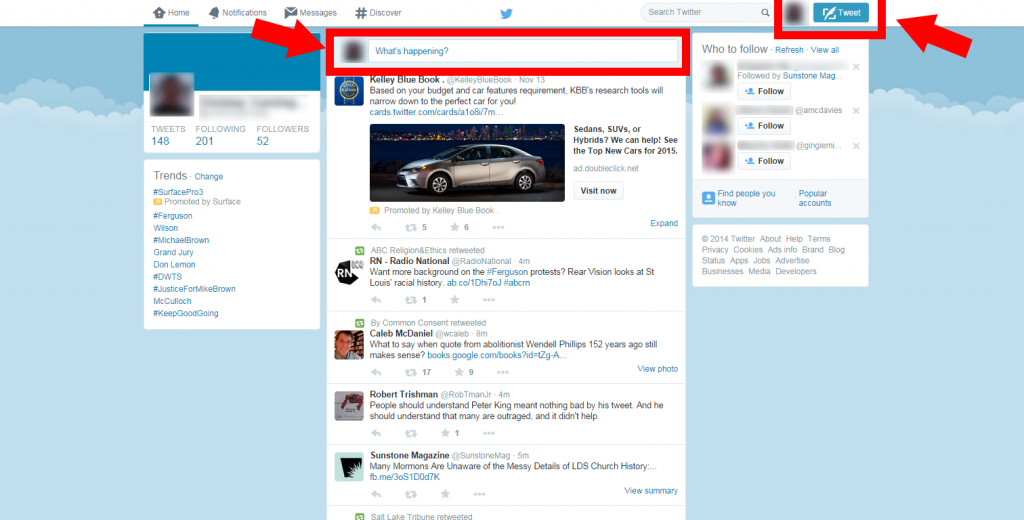 Writing a tweet is very simple. On the Twitter homepage, a box will say “What’s Happening” typing in that box will allow you to compose a tweet. There is also a “Tweet” button on the top right of the page, you can select this and a pop up for tweeting will appear.
Writing a tweet is very simple. On the Twitter homepage, a box will say “What’s Happening” typing in that box will allow you to compose a tweet. There is also a “Tweet” button on the top right of the page, you can select this and a pop up for tweeting will appear.
Sharing Content on Twitter
Because of Twitter’s focus on short content, it’s not the ideal service for sharing lots of content with your followers. To share an article, simply include a link. Twitter will not create a box for the article, so make sure that you tell people about the article you’re sharing in your tweet. To do all of this and stay in 140 characters you’ll need to use a URL shortener. Got to bit.ly or goo.gl, paste your long url, and it will provide a short version that you can use in your tweet. To share an image, click on the add photo button, at the bottom of the compose tweet screen. Then upload the photo from your computer. You can only share one image in a tweet, and the image will take up part of your 140 characters. So be brief. But tweets with images get 35% increased engagement, so make sure to include images occasionally on your Twitter feed. Like articles, you can link to any video you want. Remember to use the URL shortener, but if you want your video to appear directly in people’s Twitter feed, you’ll need to use Vine. Vine is a service that allows you to make 6 second videos.
Like articles, you can link to any video you want. Remember to use the URL shortener, but if you want your video to appear directly in people’s Twitter feed, you’ll need to use Vine. Vine is a service that allows you to make 6 second videos.
Terminology
For a full glossary check out Twitter’s page. Favorite: Underneath a tweet is a star icon. Click it to favorite that tweet. Both the authors and others on the site will be able to see your favorites. There is a favorites link on your profile page. Click it to see all your favorite tweets. Follow: A follow is someone who is following your Twitter account. Your tweets will appear in their feed. Hashtag (#): A hashtag is any word or phrase right after the # symbol, without spaces. You can click a hashtag and it will take you to a list of tweets using the same hashtag. Mention: A mention is when you include others in a tweet by using the @ symbol. Mention call also refer to the tweets where people mention you. Profile: This is the picture and bio information you include on your public page. It will also have your Twitter username, and a list of all your tweets. Retweet (RT): When someone forwards another tweet to their list of followers. Do this by selecting the Retweet icon on a tweet.
Measurements of Success
Twitter has a number of ways for others to interact with your content. And each of these types of interactions have different effects. By looking at these types of interactions, we can get a better sense of what social success on Twitter looks like.
Conversation Rate
On Twitter your conversation rate is the number of replies and mentions you get. People can reply to a tweet from an icon below each one. To increase the size of the conversation of Twitter be a part of the conversation. You are much more likely to get a response if you first respond to them. You can also get conversation rolling by asking an interesting question.
Applause Rate
Favorites are a way to tell the writer that you liked their content, and to save the tweet so you can see it again later. Favorites can be difficult to gauge. By sharing uplifting content, and speaking to your unique group of followers you will find that others favorite your content more. But beware. When someone favorites your tweet, Twitter will inform you, and some companies have begun favoriting tweets in order to increase the number of followers that they are getting, so it may not be as effective of a way to measure true success as it once was.
Amplification Rate
On Twitter, amplification occurs through retweeting. To increase the number of retweets you can simply ask people, which has shown to work (don’t over use this though.) Tweets with links also get more retweets. And users who retweet more often, have their own content retweeted more often as well. You also want to make sure you leave enough room for someone to retweet. The RT and the username of the original writer takes up space, so make sure you leave room for that if you want others to retweet your content.
Results
It can be difficult to see whether or not you are touching people through the very brief means allowed on Twitter but there are a few ways to actually measure your results. One thing to look for is that occasionally hashtags promoted by the church can be hijacked by its enemies posting vile or misleading content. By posting enough positive content on church promoted hashtags, we can drown out those voices, so that people who search for those hashtags will have a good experience. You especially want to look at your conversation rate, as a way to measure results. When you start a conversation, and can continue that, it gives people the opportunity to consider the gospel more in depth than they would through a single tweet. One last way you can see real results is through direct messages. You can only get direct messages from people you follow, so if you are interacting with someone enough on Twitter you may consider following them for that purpose alone. But many Twitter users report getting heart felt direct messages in response to religious content they had posted. This is a sign that people aren’t just interacting with the content on the computer, but also in their heart. 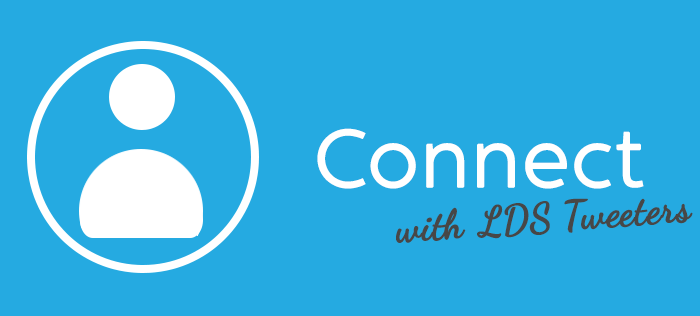
Who Should I Connect With?
Connect with other major LDS Twitter contributors to give yourself a head start.
Increasing your Connections
One way to develop as much influence on Twitter as possible is to increase your number of followers. There are some tried and true methods to making this happen:
Follow Other People
The most reliable way to develop Twitter followers is by following other people, especially when you’re first starting out. Think through your friends, family, and acquaintances, look through e-mail contacts, and contacts on other social media sites. Twitter also recommends people for you to follow. Choose “Discover” on the top bar on Twitter, and there will be a “Who to follow” recommendation list. You may also consider following those who interact with the same posts as you do.
Complete Your Profile
People are much more likely to follow you, if your profile looks complete. So include an accurate and reasonably length bio, and have both a profile and banner picture on the site. As your circumstances change, make sure to update your bio so that people know that your site is active.
Focus on Now
A lot of people go on Twitter to discuss current events. And people like to follow others who are engaging in the same conversations. So go and talk about what is happening right now. For Latter-day Saints, one of the best times to connect with each other is during general conference, when many will tweet using the #ldsconf hashtag.
Provide Value
Why do you enjoy going to Twitter? Or if you aren’t sure go back to our article on “Why Sharing the Gospel Online is Important” and look at the psychological reasons people reach out to social media. Then provide those things for your followers. If you love reading interesting sport facts, then find some and share them. If you love reading quotes from apostles, than share those. Find a reason why people would want your tweets appearing in your feed.
Advertise Your Username
This doesn’t mean you need to put together an advertising budget, it simply means making it easy for people to find you. Put your Twitter username on your other social media accounts. Consider including it on your business card. Make sure there’s a link to it on your blog or website. You want to make sure that people who want to find you on Twitter are able to do so easily.  You’ve decided that you want to use Twitter. You’re familiar with the basics of using the site. Now it’s time to use Twitter to help share the gospel.
You’ve decided that you want to use Twitter. You’re familiar with the basics of using the site. Now it’s time to use Twitter to help share the gospel.
Be authentic
While on Twitter, don’t be afraid to be yourself.
Profiles & Bio
Your profile and bio on Twitter are the perfect place to highlight who you are. Don’t be afraid to highlight your church membership in your bio. Say directly that you’re a Mormon, or refer to a part of you that’s connected the church, such as serving a mission, or a calling you may have. While your profile picture should probably be an image of you, each profile also allows for a banner picture. Your banner picture can be the Savior, like Elder Ballard’s is, you could also include an image of you at a church building or temple. The purpose of including these items in your profile is to let others know about your church membership. Some people want to talk about religion but hesitate to ask because they feel it’s a personal subject. Hinting at your church membership in your profile let’s them know you’re open to talking about it.
Interact With Others
You have three types of Twitter users, the shouters, the lurkers, and the participators. You want to be a participator. Shouters use Twitter to tell other people what they want, they don’t respond to others’ posts or interact in any meaningful way. Lurkers use Twitter to read what others are posting, but without posting their own content. A participator is someone who reads, posts, and then interacts. Use features like retweets and hashtags and respond to others’ tweets directly. Participating in the back and forth conversation is the best way to find new followers, and it increases how often your followers will engage with what you post. Twitter shouldn’t be a brand new social experience, but an extension of the way you interact with others. By being a participator you’re the most authentic kind of user.
Develop Your Niche
Most Twitter users occasionally post content about their own lives, but the most successful users use the site primarily to post a certain kind of content. What that type of content will be is up to you. If you’re funny, use Twitter to tell jokes. If you love basketball, then tweet while watching a game. Use the hashtags that others producing similar content use. By producing lots of content about the kinds of things you love, you’ll connect with others with similar interests.
Be consistent
Developing social media consistency will help people feel as though following you will be predictable and worth it.
Tweet Often
One of the primary factors in developing an audience is by tweeting often. Many Twitter users come on multiple times per day, and tweets shuffle through feeds so quickly that if you only send out one message, it’s likely to be missed by many of your followers
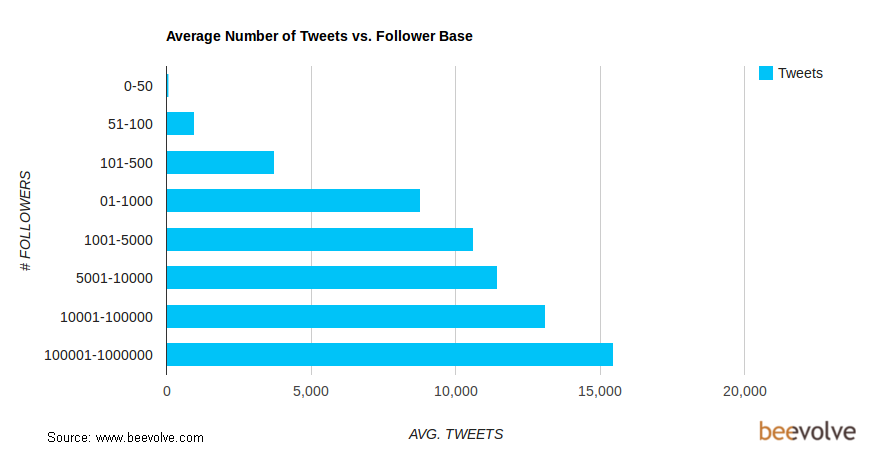
According to beevolve, there is a direct correlation between the number of tweets and the number of followers. But building up to this number should take some time. To get the most coverage of your tweets, send 14 tweets a day, and never more than one per hour. This rate creates the most engagement with your followers.
When should I tweet?
Twitter engagement is highest on the weekends. So take some time them to interact with your followers.Sunday can be an ideal time to share the highlights of church or your own religious thoughts of the day. During the day, Twitter engagement is the highest between 4 and 9 PM. Engagement peeks at 5 PM and then trails off slowly throughout the night. These can be an ideal time to share your plans with your family, or your nightly scripture study.
Cultural Consistency
You don’t want to sound out of place on Twitter or your followers are likely to disengage from you. Hashtags in particular can be difficult to master. Take some time understanding the way others on the site use them before trying your own. Twitter is also a fast paced medium. If you come to a news story late, there’s a good chance your followers won’t be interested in engaging in the content any more.
Consistent Tone
Like we mentioned earlier, finding your niche is crucial, but not everything you post has to fit in to that specific group. What you do want to keep consistent is your tone. If you use Twitter in a primarily business fashion, then you will alienate your followers with a particularly personal post. Similarly if you use the site for personal updates, a sudden sales pitch will alienate your followers.
Edify
 Twitter users flock to religious content. The rapper, P. Diddy made news in 2011 when he quoted L. Tom Perry on Twitter. One of the major reasons people come to social media is to feel good, and religious content can provide that uplift. Particularly edifying messages are difficult to construct in 140 characters, so you need to learn how to simplify your messages. If you have a longer quote, cut off the beginning and end leaving only the essential information. Elipses (. . .) are also a great tool for shortening longer messages. You can also consider the site TwitLonger.com, which allows you to participate in a conversation on Twitter, but include a longer post that will link back to the TwitLonger page.
Twitter users flock to religious content. The rapper, P. Diddy made news in 2011 when he quoted L. Tom Perry on Twitter. One of the major reasons people come to social media is to feel good, and religious content can provide that uplift. Particularly edifying messages are difficult to construct in 140 characters, so you need to learn how to simplify your messages. If you have a longer quote, cut off the beginning and end leaving only the essential information. Elipses (. . .) are also a great tool for shortening longer messages. You can also consider the site TwitLonger.com, which allows you to participate in a conversation on Twitter, but include a longer post that will link back to the TwitLonger page.
Uplift
Twitter can be a magnet for profanity, and other vulgarity, none of which is kept out of feeds. Make sure that when you use Twitter you rise above this kind of discourse. Never say anything to anyone on Twitter that you would not say to their face. And remember that even if you delete a tweet, there’s a chance a screen grab of it will make it live forever. Also be aware that Twitter posts can be read by people all over the world. Be aware of what your culture is like, and think about how someone from a different culture would understand what you’re writing. In particular think about issues such as gender, race, and sexuality to make sure that your content will not be offensive to anyone.
Be Wise
Physical Safety
Because Twitter is so easily used through mobile services, take the same precautions with Twitter on the road you would with texting. Don’t tweet and drive.
Learn the Tool
The tools of Twitter do not take long to learn, but the culture can be a little more difficult. Reading through this guide should get you ready to contribute. But for the first few days spend more time reading tweets then sending or responding to tweets. There’s no reason to take more time to observe than this, but this little bit of time will help you avoid making a misstep as you’re starting out. You can also check out the 8 basic types of tweets, to get you started with composing your own. The question tweet, is one of the best for starting a conversation.
Connect
Twitter is a great way to connect with those around you, and hashtags are one of the best ways to do it. On the left side of your Twitter feed is a list of the trending hashtags and topics. Consider writing about one of them.
Other sites, such as hashtags.org aggregate all the content and identify what topics are trending the most.
You can also participate by using hashtags that the Church is promoting. These hashtags will often appear on official church videos, or during broadcasts. The Church has a complete list of hashtags for individuals and events. By using the suggested formatting and spelling, you will make it easier for those who want to talk about the same topic to find your content.
Hashtags help identify you as participating in a specific conversation, and can connect you with other interested individuals you may have never met before.
To find all of the Church’s current social media initiatives visit social.churchofjesuschrist.org. This site will list the various ideas the Church is currently promoting.
Be Vigilant
One major challenge with Twitter is that so much information is shared without citation, and without context. Don’t believe everything you read on the site. Twitter has become infamous for starting many hoaxes that are passed along unthinkingly. A quick Google search can confirm whether most stories you see are true. Also consider checking out Snopes.com for general stories and HolyFetch.com to check if LDS themed stories are true or not.
Don’t steal
Sharing others’s content on Twitter is expected. But you must know how to do it right to keep others happy. If you share another person’s tweet, start out your tweet with “RT” along with the person’s Twitter username. If you use someone else’s word in your tweet, put it in quotation marks, and say who the quote is from, even if it takes you a second tweet to include the attribution. If you post an image or video on Twitter, users will assume you have created it, if you didn’t you must say so explicitly in your tweet.
Go Do It!
Kickstart your Twitter by completing this activity: 
Instructions
Comment on two LDS themed news articles for each of the topics below. Find articles at:
Brainstorm
| Topic | News Source | Title of Article |
|---|---|---|
| Humanitarian Aid | 1. | 1. |
| 2. | 2. | |
| Church Leadership | 1. | 1. |
| 2. | 2. | |
| Families | 1. | 1. |
| 2. | 2. | |
| Historic Events | 1. | 1. |
| 2. | 2. | |
| Missionary Work | 1. | 1. |
| 2. | 2. |
Share
- Share a link to your favorite article on Twitter
- Include relevant LDS hashtags such as #mormon, #sharegoodness, #ldschurch, or #PresMonson

Time wasting
Time wasting is not a major concern on Twitter. The brief nature of the site means most people are able to get in and out without problem. The average Twitter user spends less than 3 hours a month on the site. But there is something tempting about being able to refresh your feed. With a never ending source of tweets to read, you can’t read everything and have to learn how to cut yourself off.
Anonymity
While it’s not the way the service should be used, setting up an anonymous Twitter account is easy. Because the site shouldn’t be used this way, avoid any user who doesn’t have their name on their profile page.
Psychological
 Twitter engagement is very high, and its easy to become over reliant on the service if many of your friends and family are on it. So remember to take a break, and interact with people face to face. As long as Twitter is a way for you to augment your relationships, instead of replacing your relationships you’re on safe ground. Also, while you may complain about the complaints you read on Twitter, the overwhelming majority of Tweets are positive about people’s lives. When we base what we know about others from these positive glimpses, we may inaccurately think our lives are worse by comparison. This is another reason why getting to know people completely is important, because the glimpses we see on Twitter aren’t entirely accurate, and can lead to depression.
Twitter engagement is very high, and its easy to become over reliant on the service if many of your friends and family are on it. So remember to take a break, and interact with people face to face. As long as Twitter is a way for you to augment your relationships, instead of replacing your relationships you’re on safe ground. Also, while you may complain about the complaints you read on Twitter, the overwhelming majority of Tweets are positive about people’s lives. When we base what we know about others from these positive glimpses, we may inaccurately think our lives are worse by comparison. This is another reason why getting to know people completely is important, because the glimpses we see on Twitter aren’t entirely accurate, and can lead to depression.
Privacy
While there are a few things you can do to increase your privacy on Twitter, the purpose of the service is to share with the world, so know and understand that going in. The only time others can’t see your message is if it is a direct message between you and one of your followers. This presentation goes over the basic promises you make in Twitter’s user agreement, that can help you understand your privacy rights on the site.



